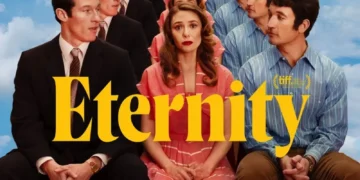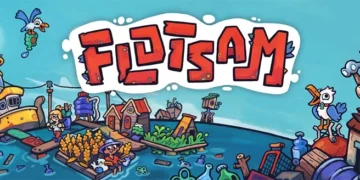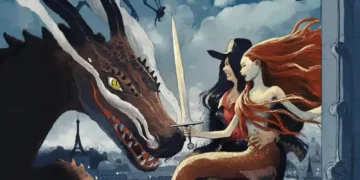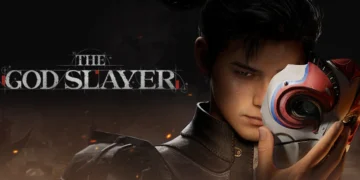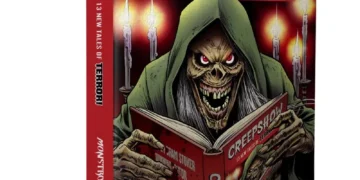Written by: G.S. Faulk, Sidney Maris Hargrave, Rowan Hartford, Robert Wolinsky, T.R. Racki, Erik Bitmanis, Gary Moloney, Jenn Arledge, Josh Keeling, Mike Lynch, Nicholas Poonamallee, Julian Dominguez, Jonathan Ward, Jerreau Driessen, Zackary Rupp, Robert L. Eoff, Jamie Me.
Art by: Gian Carlo B Bernal, Sidney Maris Hargrave, Nicolo Arcuti, Luzco Lumaga, Massimo Sabadin, Mary Anne Mackey, Mharz, Kevin Pass, Samn judge, Cristian Baldi, Scott Malin, Eilidh Price, Melissa Capriglione, Ricardo Enguita, Edgardo Granel-Ruiz, Robert L. Eoff, Michelle Stanford.
Colours by: Angela Zhang, Rowan Hartford, Ellie Wright, Micah Weltsch, Jeff Edis, Kayla Swain, Jess Drake.
Letters by: Albert Creswell, Luzco Lumaga, Julie Gravelle, Jenn Arledge, Scott Malin, Jess Drake, Jonathan Carter.
Cover by: Luzco Lumaga
Published by: Comic Book Hour
“Power-Ups: Vilified” (PUV) is the first comic anthology produced by Comic Book Hour, a community best known for their weekly discussions on twitter. At 104 pages, the anthology contains sixteen self-contained stories, all of which were inspired by the following writing prompt:
“I am not what they think I am”
The collection is not specific to any one genre, with everything from horror to fantasy to legal dramas in between. The anthology also features a great deal of collaboration, with creators from all over the world involved in a series of projects only tenuously tied together.

It is this last concept, which in many ways should damn an anthology, that actually makes PUV such an enjoyable read. Rather than focus on restrictive, heavy-handed cohesion, PUV allows each contributor to steer the overall project in a new direction. Indeed, this pays a sort of zany homage to the theme of the collection itself, which if anything, pokes fun at the now outdated view that grassroots efforts cannot produce works in league with bigger-bucks publishers.

The anthology bounces a number of emotions off the reader, with sad stories and thought pieces often padded by more light-hearted tales of humour. At a microscopic level, a number of entries in particular give the collection weight, lending it the sort of credibility needed to punch at prize-fight level. “Whispers” by G.S. Faulk is not a comforting story, but nor does it set out to be, and it’s perhaps that cerebral quality which causes it to leave such a lasting impression. On the contrary, it’s the near-nostalgic comedy in “Smuggler’s Run” (Erik Bitmanis) which makes the noir depression-era tale worth a second glance. “The Monster” (Jenn Arledge), a four-page tale that reads all too quick, interestingly becomes an economic masterpiece in its final panel. Arledge’s use of misdirection is memorable in a story made all the more unsettling by the cartoonish artwork (Mharz, Micah Weltsch). “Cognitive Dissonance” (Nicholas Poonamallee) and “Obsessed” (Jamie Me) seem tired concepts at face value, but both offer succinct and refreshing outlooks, with Me’s work in particularly sharp as a critique of the creative process. In some sense, “Colour-Line” (Zackary Rupp) is equally poignant, in this case for its political overtones.

Of course, the real thrill of PUV was that it featured one of Comicbuzz’s own, as Cork native (Dublin-based) writer Gary Moloney made his debut in “Lex Iniusta”. A stellar team of Mary Ann Mackey (Art), Ellie Wright (Colouring), and Julie Gravelle (Lettering) accompanied Moloney on his first foray into published work, providing second-to-none production values for the legal drama with a supervillain twist. “Lex Iniusta” is certainly on the lighter end of the spectrum in terms of tone seen in PUV. But whereas this stylistic choice doomed many similar stories to B track status, “Lex Iniusta” certainly balanced its flare for sarcastic humour with its intent to ground a reader in its story. Given the four-page limit imposed, Moloney also does well to keep the clock ticking over in terms of pace while still searching for the very rewarding, ever-satisfying conclusion he arrives at. As we end with the image of a business card, a symbol which perfectly marries the law and superhero worlds together, we can’t help but hope for a sequel, a mean feat if any given we only met our protagonist a dozen or so panels before. In many ways, Moloney’s work provides evidence as to why “Power Ups: Vilified” works as an anthology. Ultimately, a grassroots project such as this is truly in touch with its stories, and as an extension, with the writers behind them too. Yes, these creators are not what you think they are.
They’re something more exciting still.
Overall: 9/10
Kyle is a pharmacy graduate who spends most of his free time playing with words. A fan of sci-fi and fantasy, he runs a blog over on yourelisteningnow.com and is currently working on his first novel, Mist Rock (italics). In the past he wrote with the award-winning UCC Motley magazine and was nominated for the 2016 Colour Writer of the Year at the SMedia awards.


